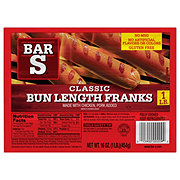
natural colorings that is odd, that not only do people prefer it but that they’ll go to great lengths to make sure that’s what they eat, even though there are no flavor differences. Bean added its signature coloring as a way of making its frankfurters stand out amid a sea of competitors. One legend has it that the coloring historically was added by the original European makers of frankfurters to mask less-than-premium ingredients … Smith, however, speculated that W.A. It isn’t entirely clear why the red coloring was introduced. Bean fan from North Carolina drives north every three or four weeks to get a fix of his favorite dog. Over time, the map became so crowded that maintaining it was no longer feasible … Maine exiles also snatch them up while visiting ‘home’ to bring back to share with their families and friends, Smith said, noting that one W.A. map on display, with push pins marking everywhere their snappers were shipped, sometimes in orders as large as 10 pounds at a time. Smith said the company used to have a large U.S. Bean produces an estimated 400,000 pounds of snappers each year, both under its own name and the Rice’s label that the family began producing nearly a decade ago, after negotiating a deal with its former owner and former competitor. Bean & Sons … has been making the natural casing treats since 1918 … ‘We are the only makers of the red hot dogs left in the state of Maine,’ said … W.A. Local media in Maine reports on this from time-to-time, noting not only the popularity but also versions of the reason behind the red coloring: Prepping the red hot dogs and buns in an electric skillet.

From a food manufacturing standpoint, I imagined the process would put the completed natural casing frankfurters through a vat of dye prior to packaging. The amounts of the other ingredients may have differed, but it wasn’t likely.

The only obvious difference is the red coloring. Ingredients: Beef and pork, water, corn syrup, contains 2% or less of salt, potassium lactate, flavorings (including extractives of paprika), dextrose, sodium diacetate, ascorbic acid (vitamin C), sodium nitrate, in a natural lamb casing. I then located the Natural Casing Frankfurters from the same meatpacker: Searching the case I found some meatpackers also throw in FD&C Yellow #6. Ingredients: Beef and pork, water, corn syrup, contains 2% or less of salt, potassium lactate, flavorings (including extractives of paprika), dextrose, sodium diacetate, ascorbic acid (vitamin C), sodium nitrate, FD&C red #40 and red #3, in a natural lamb casing. Red frankfurters are served in what are called Frankfurter or Frankfort Rolls.Ĭurious, I flipped over one of the packages of red frankfurters: Then why are they red? “I really don’t know, that’s always confused me, too.” “No, they’re not.” How are they different from other natural casing frankfurters from the same meatpackers? “They taste the same” was the answer. I was curious when I saw these in the grocery store so I asked a manager if they were hot or somehow spicy. For example, some of the oddest hot dogs I’ve seen are the red frankfurters of Maine. Local and regional traditions are important in many ways, and can be informational, historical, or even humorous in nature. Red frankfurters in a grocery case in Lewiston, Maine.

BAR S HOT DOGS INGREDIENTS PLUS


 0 kommentar(er)
0 kommentar(er)
